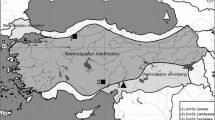Abstract
Specimens of O. americanus collected in eight localities from Rio Grande do Sul and four from Paraná (Brasil) were studied. Patterns of chromosomal localization and activity of nucleolar organizer regions (NORs) were established using the silver banding technique. It was shown that diploid and tetraploid specimens from all localities have homologues of group 4 bearing active NORs. In addition, some populations showed NOR activity on only one homologue number 5 (Uruguaiana, Prudentópolis), 8 (Itaqui) or 2 (Pato Branco). Intrapopulation polymorphism was found, some specimens showing the extra band and others not. Most cells analysed from the intestinal epithelium of an individual showed the same particular staining pattern of NORs, which were unequally stained, suggesting differences in their activity. The tetraploid genomes showed a maximum of five and a minimum of two active NORs. Diploid genomes showed two active NORs and four in the case of one specimen from Pato Branco. Four diploid populations and sympatry of 2n and 4n animals in Santa Bárbara do Sul (RS) were detected for the first time in South Brasil. Karyological evolution, as well as the meaning of number and unequal activity of NORs on tetraploid genomes are discussed.
Similar content being viewed by others
References
Batistoni R., Andronico F., Nardi I. & Barsacchi-Piloni G., 1978. Chromosome location of the ribosomal genes in Triturus vulgaris meridionalis (Amphibia, Urodela) III. Inheritance of chromosomal sites for 18s+28s ribosomal RNA. Chromosoma 65: 231–240.
Beçak W. & Goissis G., 1971. DNA and RNA content in diploid and tetraploid amphibians. Experientia 27: 345–346.
Beçak W. & Pueyo M. T., 1970. Gene regulation in the polyploid amphibian Odontophrynus americanus. Expl Cell Res. 63: 448–451.
Beçak W., Schwantes A. R. & Schwantes M. L., 1968. Polymorphism of albumin-like proteins in the south american tetraploid frog Odontophrynus americanus (Salientia: Ceratophrydidae). J. exp. Zool. 168: 473–476.
Bloom S. E> & Goodpasture C., 1976. An improved technique for selective staining of nucleolar organizer regions in human chromosomes. Hum. Genet. 34: 199–206.
Lentzios G. & Stocker A. J., 1979. Nucleolar relationships in some australian Chironomus species as shown by Ag-As banding and other cytological techniques. Chromosoma 75: 235–258.
Lima de Faria A., 1976. The chromosome field I. Prediction of the location of ribosomal eistrons. Hereditas 83: 1–22.
Miller L. & Brown D. D., 1969. Variation in the activity of nucleolar organizers and their ribosomal gene content. Chromosoma 28: 430–444.
Miller L. & Gurdon J. B., 1970. Mutations affecting the size of the nucleolus in Xenopus laevis. Nature 227: 1108–1110.
Miller D. A., Dev V. G., Tantravahi R. & Miller O. J., 1976a. Suppression of human nucleolus organizer activity in mouse-human somatic hybrid cells. Expl Cell Res. 101: 235–243.
Miller O. J., Miller D. A., Dev V. G., Tantravahi R. & Croce C. M., 1976b. Expression of human and suppression of mouse nucleolus organizer activity in mouse-human somatic cell hybrids. Proc. natn. Acad. Sci. U.S.A. 72: 4531–4535.
Nardi I., De Lucchini S., Barsacchi-Piloni G. & Andronico F., 1978. Chromosome location of the ribosomal RNA genes in Triturus vulgaris meridionalis (Amphibia, Urodela) IV. Comparison between in situ hybridization with 3H 18s+28s rRNA and AS-SAT staining. Chromosoma 70: 91–99.
Ruiz I. R. G. & Beçak W., 1976. Further studies on polyploid amphibians. V. C-banding in diploid and tetraploid species of Odontophrynus. Chromosoma 54: 69–74.
Ruiz I. R. G., Soma M. & Beçak W., 1981. Nucleolar organizer regions and constitutive heterochromatin in polyploid species of the genus Odontophrynus (Amphibia, Anura). Cytogen. Cell Genet. 29: 84–98.
Schmidtke J., Beçak W. & Engel W., 1976. The reduction of genic activity in the tetraploid amphibian Odontophrynus americanus is not due to loss of ribosomal DNA. Experientia (Basel) 32: 27–28.
Schwantes M. L. & Schwantes A. R., 1977. Eletrophoretic studies on polyploid amphibians—III. Lack of locus duplication evidences through tetraploidization. Comp. Biochem. Physiol. 57B: 341–351.
Sinclair J. H., Carrol C. R. & Humphrey R. R., 1974. Variation in rDNA redundancy level and NOR length in normal and variant lines of the mexican axoltl. J. Cell Sci. 15: 239–257.
Sumner A. T., 1972. A simple technique for demonstrating centromeric heterochromatin. Expl. Cell Res. 75: 304–306.
Author information
Authors and Affiliations
Rights and permissions
About this article
Cite this article
Ruiz, I.R.G., de Almeida, T.M.B. & Beçak, W. Active nucleolar-organizer regions in polyploid populations of Odontophrynus americanus (Amphibia, Anura) from South Brasil. Genetica 63, 31–37 (1984). https://doi.org/10.1007/BF00137462
Received:
Accepted:
Issue Date:
DOI: https://doi.org/10.1007/BF00137462




